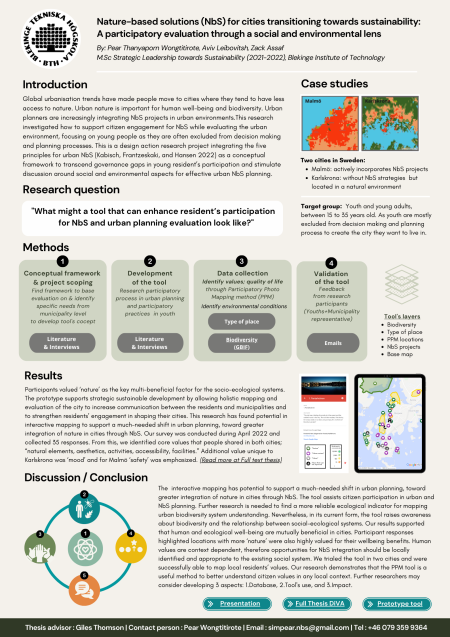
Objective:
Global urbanization trends have made people move to cities where they tend to have less access to nature. Urban nature is important for human well-being and biodiversity, therefore urban planners are increasingly integrating Nature-based Solutions (NbS) projects in urban environments.
This research investigated how to support citizen engagement for NbS while evaluating the urban environment, focusing on young people as they are often excluded from decision-making and planning processes.
The research design included a literature review and interviews with city planners, to develop a Participatory Photo Mapping (PPM) tool to enhance resident participation and stimulate discussion around social and environmental aspects for effective urban NbS.
The prototype tool consists of a multi-layer map combined with NbS projects, locations, and photos reported by participants (from two Swedish cities, Malmö and Karlskrona), and two environmental indicators: land cover and biodiversity occurrence. Participants identified locations they perceived as improving or hindering the quality of life and the natural environment.
Participants valued ‘nature’ as the key multi-beneficial factor for the socio-ecological systems. The prototype supports strategic sustainable development by allowing holistic mapping and evaluation of the city to increase communication between the residents and municipalities and to strengthen residents’ engagement in shaping their cities.
Potential impacts/benefits:
We structured our discussion around Kabisch, Frantzeskaki, and Hansen's (2022) 5 NbS principles. The key findings from the research include:
1. System understanding: We developed our research and tool for a better understanding of the interconnected social and ecological systems. Using a systems thinking approach enables open space for collaboration in cross sectors to help overcome siloed thinking in city’s planning and gain a holistic view to tackle sustainability challenges together with citizens. Applying the PPM approach can help city planners to gather context specific information relevant to their city and appropriately integrate NbS.
2. Benefiting people & Biodiversity: Mapping indicators for both social and ecological systems, has shown ‘nature’ as a shared theme for improving perceived well-being. The tool allows the city planners to realize resident’s (and in our proof of concept, young residents') perceptions while understanding environmental conditions in the valued locations. This supports urban planners in identifying the need for strategic multi beneficial solutions, such as NbS. This can increase accessibility to common spaces for nature and human, creating human connections and ecosystems.
3. Inclusive solutions for the long-term: The developed tool is an online interactive platform that is accessible for everyone. The chosen platform can increase youth participation, as they are familiar with online activity. This tool allows residents to freely express ideas and thoughts about how they perceive the city and what can be improved. This strengthens social sustainability by giving residents the power to have influence in the system they are a part of.
4 Context consideration: Each city is unique in its environmental conditions and historical, cultural values so considering local insights can assist planning for integration of NbS in cities. The tool helps to map and understand what is meaningful and valuable for residents in their city. For example, in Malmö, participants highlight picnics, activities in the sun and on the urban setting as modern and futuristic. In Karlskrona, participants focused on individual activities, the quietness and wilderness from nature, and on historical elements. This feeling of meaning can increase residents’ participation, wishing to protect their valued places, or even create other meaningful places. This relates to the different city settings and supports decision makers with information on how they can enhance NbS design that fit in the specific context.
5. Communication & Learning: At the core, the tool is a communication device to support the evaluation of urban planning and promote integration of NbS. Through the participatory process, it creates conversation between decision makers and residents. Municipalities can learn from residents' insights and environmental aspects to work towards strategic sustainable development. Consideration of their insights will encourage residents to participate, feeling capable of their influence. In addition, the tool enables residents to learn about urban NbS and explore their local environment and biodiversity which can help promote a shift in values and foster environmental protection. This can generate a positive feedback loop to adapt NbS transformations towards sustainability.
Organisations:
Blekinge Institute of Technology University | Master's Strategic Leadership towards Sustainability
Design team:
Aviv Leibovitsh, Zouheir Assaf, Pear Wongtitirote
Contacts:
Global goals:
-
11. Sustainable cities and communities
NBS goals:
- Enhancing sustainable urbanization
- Urban regeneration through nature-based solutions
- Nature-based solutions for improving well-being in urban areas
NBS benefits:
- Improve connectivity and functionality of green and blue infrastructures
- Increase quality and quantity of green and blue infrastructures
- Increased cultural richness and biodiversity
- Enhancing sustainable urbanisation
- Changing image of the urban environment
- Increase awareness of NBS solution & their effectiveness and co benefits
- Increase communities’ sense of ownership
- Increase social interaction
- Social inclusion
- Social learning about location & importance of NBS